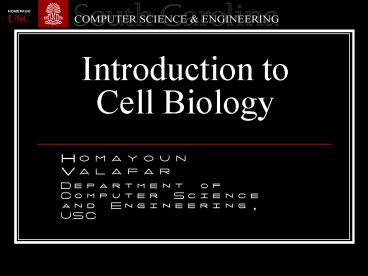Introduction to Cell Biology - PowerPoint PPT Presentation
1 / 15
Title:
Introduction to Cell Biology
Description:
Intracellular structure that contains the genetic material (DNA). Pseudo spherical in shape. ... region of the cell with high density of DNA (in Prokaryotes) ... – PowerPoint PPT presentation
Number of Views:110
Avg rating:3.0/5.0
Title: Introduction to Cell Biology
1
Introduction to Cell Biology
- Homayoun Valafar
- Department of Computer Science and Engineering,
USC
2
Cell (Biological)
- Smallest unit of life.
- Smallest collection of matter that can live.
- What is life? Hard to answer...
- Order
- Reproduction (sexual/asexual)
- Growth and development
- Energy utilization (metabolism)
- Response to environment
- Homeostasis
- Evolutionary adaptation
3
Two Types of Cell
- Eukaryotic Cell
- Higher organisms (mammals, vertebrates, etc.)
- Human
- Mouse
- Drosophilia melanogaster (Fruit fly)
- Caenorhabditis elegans (C. Elegans, earth worm)
- Prokaryotic Cell
- Bacteria and Cyanobacteria (blue-green algae)
- Escherichia Coli (E. Coli)
- Pyrococcus Furious (P. Furious)
4
Anatomy of Cells
5
Anatomy of a Eukaryotic Cell
- Cell membrane (Plasma Membrane, Bilayer)
- Cytoplasm
- Organelle
- Nucleus
- Mitochondria
- Ribosome
- Endoplasmic reticulum
- Golgi apparatus
6
Cell Membrane (Bilayer)
- Encapsulates all functional components of the
cell and the Cytoplasm. - Insulates and isolates cell internals from
external elements. - Composed of lipid bilayer.
- Water insoluble.
- Contains embedded trans-membrane proteins.
- Surface Carbohydrates as markers.
7
Cytoplasm
- The entire portion of the cell interior not
occupied by the nucleus. - Very dynamic environment.
8
Organelle
- Membrane-bound intracellular compartments.
- Distinct and highly organized.
- Contain specific chemicals to perform specific
cellular function. - Suspended in the cytoplasm.
- Only in Eukaryotic cells.
9
Nucleus
- Intracellular structure that contains the genetic
material (DNA). - Pseudo spherical in shape.
- Usually near the center of the cell.
10
Mitochondria
- Cellular organelle responsible for energy
production. - Contains enzymes for oxidative phosphorylation.
- Site of Krebs cycle (conversion of sugar
byproducts into units of energy). - Most peculiar made up of double bilayer
membranes. - Evidence of evolution???
11
Ribosome
- Protein synthesis machinery.
- Free floating in cytoplasm.
- Bound to rough-Endoplasmic Reticulum (RER) in
Eukaryotes. - Consists of multiple subunits composed of
RNA-protein complexes.
12
Endoplasmic Reticulum
- Organelle consisting of network of fluid-filled
tubules and flattened sacs. - Synthesis of proteins and lipids for formation of
new cell membrane and other cellular components. - Manufactures products of secretion.
- Rough or smooth types.
13
Golgi Apparatus (Golgi Complex)
- Organelle consisting of network of fluid-filled
tubules and flattened sacs. - Processes raw material transported to if from the
ER into finished material (Glycocylation, etc.) - Sorts the finished products and directs them to
their final destination.
14
Other Organells
- Lysosome
- The main function of these microbodies is
digestion. Lysosomes break down cellular waste
products and debris from outside the cell into
simple compounds, which are transferred to the
cytoplasm as new cell-building materials. - Peroxisomes
- Peroxisomes function to rid the cell of toxic
substances, in particular, hydrogen peroxide
15
Eukaryotic versus Prokaryotic
- In general Prokaryotic cells are much simpler in
anatomy than the Eukaryotes. - Prokaryotes do not possess organelles.
- Prokaryotes do not have nucleus (membrane bound
DNA). Nucleoid region region of the cell with
high density of DNA (in Prokaryotes). - Eukaryotes usually consist of more complex DNA
(in number and coding, introns/exons later).





![[PDF] Molecular Biology of the Cell Free PowerPoint PPT Presentation](https://s3.amazonaws.com/images.powershow.com/10081897.th0.jpg?_=202407190210)

























